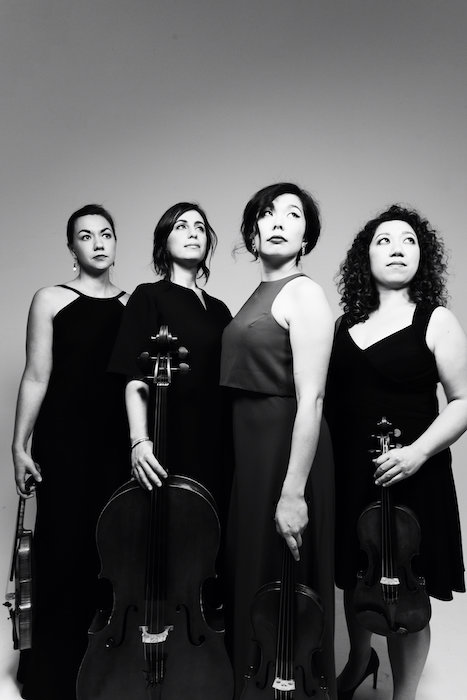Aizuri Quartet impresses in classics and contemporary works at Rockport

The Aizuri Quartet performed Thursday night at the Rockport Chamber Music Festival. Photo: Sherwin Lainez
Caroline Shaw and Gabriella Smith hold the string quartet tradition in such high esteem that each composer out to build upon the styles of past composers. Shaw’s Blueprint from 2016 reworks a familiar quartet by Beethoven. Smith’s more eclectic Carrot Revolution from 2015 brings together the diverse sound worlds of Bartók, Ligeti, Steve Reich, and even The Who.
But when played by the Aizuri Quartet, who offered them as part of the Rockport Chamber Music Festival at the Shalin Liu Performance Center Thursday night, these works revealed just as much about the ensemble for which they were written.
Shaw and Smith wrote their respective scores for the Aizuri musicians, who recorded them for their debut album, Blueprinting, in 2018. Both pieces require a bit of daring. Timbres change on a dime, and the music churns ever forward through shifting textures and bristly soundscapes.
Shaw herself described Blueprint as a harmonic reduction of Beethoven’s String Quartet, Op. 18, No. 6. In her tasteful, if gestural reimagining, silences frequently interrupt snippets from the slow movements of that quartet. But as the music progresses those phrases coalesce into repetitive chords that slide eerily in and out of closely related keys. A nimble coda, borrowed from the final movement of Beethoven’s quartet, brings the six-minute work to a humorous conclusion.
Smith’s Carrot Revolution is similarly engaging. Throughout its eleven-minute length, the musicians are called upon to create all sorts of percussive effects. Scratchy figures in the violins and viola form a propulsive groove as the cello taps out syncopated rhythms on the body of the instrument. The frenzy slowly reveals a driving middle section that mixes minimalism with bluegrass fiddling. As in Blueprint, the lines slip in and out of tune to colorful effect, at one point even fusing into dense, Pendereckian harmonic clusters. Intensity builds again and the music ends with a return to the opening hypnotic groove.
Thursday’s performances of both works showed that the young Aizuri Quartet is a group to watch. Though relative newcomers to the scene, these musicians played with the technical polish and silvery blend of a veteran ensemble. Violinists Gabriela Diaz and Miho Saegusa tossed off the wild sound effects and trickling runs of each score while violist Ayane Kozasa and cellist Karen Ouzounian answered them with the verve of a dance band rhythm section.
Together the musicians wove the disparate musical elements of Blueprint with an eye towards the larger structure. The abstracted score lacks a sense of sweeping melody, but the Aizuris managed to find a subtle grace and sensitivity in its softer moments. Carrot Revolution showcased the musicians maneuvering Smith’s twisting rhythms and sudden glissandos with machine-like precision.
In their hands, Haydn’s String Quartet in B minor, Op. 64, No. 2 sounded just as bold and revelatory. Composed in 1790, this quartet shows a composer experimenting with a more contemplative style.
It is also exuberant, even forward-looking in certain parts. Playing with a roughness of tone, the Aizuri Quartet injected a rustic vitality into the latter movements. The Menuetto coursed with vibrancy of a Beethovenian Scherzo, and the finale, rendered with a grinding sonority that highlighted underlying dissonances, seemed to anticipate Bartók.
The Aizuri Quartet is capable of wide stylistic contrasts, and they performed the first movement with keen attention to nuances of phrase, dynamic shading, and shifts in tonality. The Adagio, the centerpiece of Haydn’s quartet, moved with aria-like freedom.
A similar clarity and momentum marked their performance of Beethoven’s String Quartet in B-flat, Op. 18, No. 6.
After a lively treatment of the opening statement, the musicians settled into the lyrical second theme with plush blend. The development section was mercurial; the recapitulation carried dramatic weight to the concluding measures. As in the Haydn, the Aizuris brought smooth-toned resonance to the Adagio. In the Scherzo, they maneuvered Beethoven’s shifting accents with dance-like flair.
The heart of the quartet is the finale, “La Malinconia.” The musicians sculpted the somber lines in long arcs. The coda took off with a sudden jolt that carried the energy towards a satisfying conclusion.
The Rockport Chamber Music Festival continues with the Art of Time Ensemble playing waltzes by Strauss, Korngold, Liszt, Shostakovich, Rave, and others 8 p.m. Friday at the Shalin Liu Performance Center. rockportmusic.org; 978-546-7391
Posted in Performances
Posted Jun 29, 2019 at 10:58 pm by Manuel Diaz
Great review for a great concert